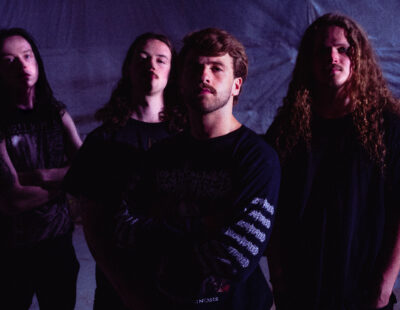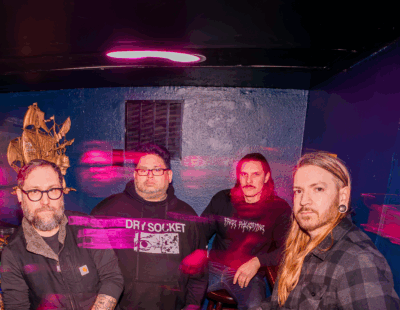
Penelope Spheeris was the first filmmaker to go inside the emerging heavy metal and hardcore scenes in the United States. Her Decline of Western Civilization documentaries are required viewing for anyone who wants to understand how extreme music developed, and her feature film Suburbia was an accurate slice of the ’80s hardcore scene in suburban America. Spheeris went on to Hollywood success in the ’90s with Wayne’s World and Black Sheep but never lost touch with her roots.
In 1999 she was offered full access to document Ozzfest, then in its fourth year. Her documentary We Sold Our Souls for Rock ‘n Roll chronicled the Osbourne clan before they became mainstream stars. It offers an intimate look at the infancy of nu-metal artists like Slipknot before they became globally famous and plenty of metal fans behaving badly moments a la Heavy Metal Parking Lot. The Academy Museum of Motion Pictures is screening the film in Los Angeles tonight (along with a conversation after with Spheeris). The film sadly remains unreleased, but Spheeris tells Decibel that might change.
This film does a wonderful job of encapsulating where mainstream metal was in the late ’90s. Why wasn’t it released?
God hates me (laughs). I’ll try to answer, but it’s a better question for Sharon Osbourne. I can tell you my perspective, but there are always two sides or more to each story. I’d known Sharon and Ozzy for 20 years before we did this movie. We tried to do another movie previously. Sharon wanted to do a love story set in the Ozzfest festival. I told Sharon a scripted piece wouldn’t work but a documentary would.
I later asked one of the producers to ensure all the music was cleared (for use). They said it was cleared in the contracts before the tour started. I kept working on the movie for two years. I later found out the music wasn’t cleared and I don’t know why.
So it was a rights issue?
Yes, music and publishing rights. We needed to have the original music cleared. They said we couldn’t release the film until the bands signed on. I’m guessing some bands asked for more money than she could pay. She decided to move on. It was a knife in my heart.
Could the film be released or streamed in the future?
Yes. I met with Sharon last week, and she said she has a plan to get it into distribution and it seems viable. It would be great to release it and do screenings, but it may go to streaming. It seems to be coming back to life after 20 years, partially due to the Academy Museum. They supported the film and wanted to show it. And now Sharon wants to get it to the masses.
As the person who documented the rise of metal and hardcore culture in the early ’80s what had changed or stayed the same by 1999?
The age group attracted to the shows largely stayed the same: teens to mid 20s. But in 1999 there was also a bit of an older audience.
Slipknot, Deftones and Fear Factory are now household names in the metal scene. Slipknot now has its own festival. You documented them in the early parts of their career.
I feel very fortunate that I could do it. It’s a historical document now. I feel fortunate that I was in the right place to do this. I can’t take credit for casting the bands — Sharon and Ozzy were smart enough to feature these bands.
How did you end up visiting the Lincoln Memorial with Slipknot? That scene stuck with me.
I got a five- or six-person crew together. After a while, a lot of the cities look like Toledo. Sharon gave us a tour bus, and I tried to think: “What does this city have that is unique to put a band in?” I said we had to go to the monuments when we were in DC. I wasn’t sure if we would get in trouble. When we went to San Francisco, talking to Slayer in Alcatraz seemed to make sense.
Jeff Hanneman, Paul Gray and Joey Jordison (Slipknot) and Wayne Static have passed. You filmed them when they were young men.
I was recently thinking about the people in the film who aren’t with us now, and it’s shocking and very sad. I am happy to have captured them in their prime. Ozzy is still here!
Somehow all four original members of Sabbath are still with us.
Because they sold their soul to the devil (laughs). Listen, you never know who will stay or go. I can’t believe I’m still here quite honestly.
This footage was shot the same year as the doomed Woodstock ’99. Ozzfest was never a logistical nightmare like that event. But I wonder if you saw anything that bothered you,
Woodstock didn’t have Sharon Osbourne planning it. Ozzfest went smoothly even with 50,000 people. There were always enough Porta Potties. There is a scene [in We Sold Our Souls] where topless girls ride a mechanical bull. I have a daughter, and I kept thinking “I hope their mom doesn’t see this.” Now I think: “I hope their children don’t see this.” That was what Ozzfest was like. It was the cut-loose-right-now mentality,
You’ve been documenting this subculture almost your entire adult life. What have learned about the human condition making these movies?
That’s a deep question. I haven’t done music films since We Sold Our Souls. It was so painful when it wasn’t released that I didn’t think I could live through that again.
I always tried to understand myself and why the young generation did what they do. Every generation is finding their identity and has a lot of angst. I learned a lot about myself and why young people act like they do.
There was always a real honesty to your films.
I never wanted to impose my ideas on the viewer. I wanted to show what I saw. Just turn the camera on and let people draw their own conclusions.
What do you think of the fact that your early film subjects Keith Morris and Jack Grisham are still performing?
Oh my God, the Circle Jerks and T.S.O.L. God bless them. They still have integrity.







